At two pounds flat, the Asus Eee PC is the smallest ultra-cheap PC on the market, yet it's arguably the most capable of the bunch. Design-wise, the Eee draws on Asus's long history of notebook design: It's altogether a solid and streamlined machine. People who don't see the display might assume you paid thousands for it. This ain't no Vista laptop, though: The Eee runs Xandros Linux and is simplified to the point of obviousness. Jumbo icons let you launch a web browser, Skype, office apps, and the like, all separated by tabs to let you know if it's "Work," "Play," "Internet," and so on. Linux n00bs won't have any trouble setting up wireless, managing files, and even snapping pics on the integrated webcam. On the downside, the Eee's diminutive size mostly relegates it to novelty status instead of business tool. The asus eee pc battery keyboard is too small for touch typing, and the screen is just too tiny to fit much information on at once.
WIRED Possibly the best ultraportable laptop you can buy, and for a mere $400. Available in multiple colors. Serious hackers can go nuts and add extra apps and even install Windows or other Linux distributions. 4GB solid-state drive means no crashes when you drop it.
TIRED Two hours and 20 minutes of battery life disappoints considering the slimmed-down specs. Only 1.3GB free storage space available straight out of the box. Stiff (and tiny) mouse buttons.
Thursday, February 26, 2009
Review: Asus Eee PC 4G
Sunday, February 22, 2009
HP Pavilion dv9000 laptop. Removing hard drive, memory, wireless card, keyboard

These instructions will help you remove hard drive, memory, wireless card and keyboard from a HP Pavilion dv9000 series laptop. All these components, except the keyboard, can be accessed through the bottom of the laptop.
In the next guide I will explain how to disassemble laptop display panel and remove inverter board with LCD screen.
Do not disassemble your laptop if it's still covered by the manufacturer's warranty or you loose the warranty. Are you looking for spare parts for your HP Pavilion dv9000 laptop?

First of all, remove the battery. Remove screws from the 1st hard drive and memory covers. Remove both covers.
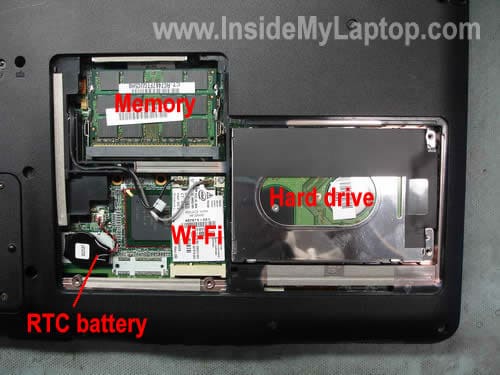
Under the memory cover you will find the wireless card and RTC battery.
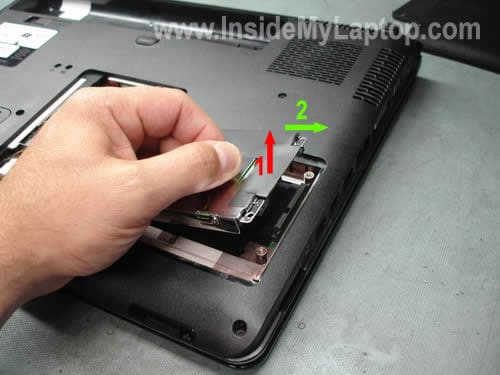
In order to remove the hard drive, lift up the right side of the drive assembly (move 1) and then pull it to the right (move2). If you are replacing the hard drive, you'll have to transfer the caddy and connector to the new drive.

Before you remove the Hp Pavilion dv9000 battery and wireless card, you'll have to disconnect both antenna cables pointed with green arrows. Simply unsnap both antenna cables from the wireless card with your fingers. After that remove two screws securing the wireless card and pull it from the slot by the edges.

Some Pavilion dv9000 laptops have only one hard drive installed. As you see, in my case there is no second hard drive under the cover.
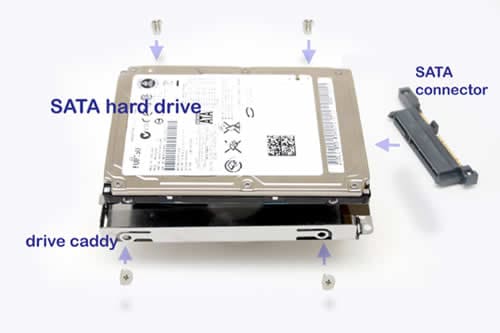
If you would like to install second hard drive into your notebook, you'll have to purchase a new SATA drive, SATA connector and drive caddy. You'll find step by step hard drive installation instructions in this guide.
we will refer to all HP Pavilion dv9000 battery, dv9000t, dv9100, dv9200, dv9300, dv9400, dv9500, dv9600 & dv9700 notebooks as the "dv9000″ since adding a hard disk drive (HDD) to all above mentioned notebooks are similar.
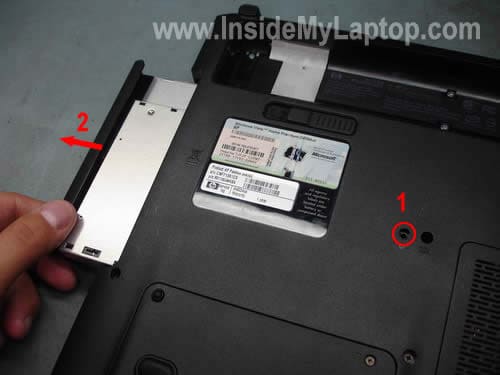
In order to remove the CD/DVD drive you'll have to remove the securing screw (1) and then carefully pull the drive from the laptop.
KEYBOARD REMOVAL INSTRUCTIONS
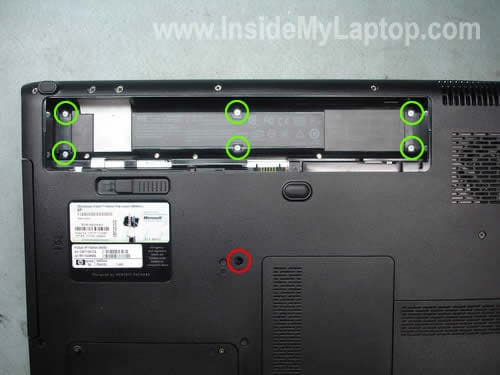
Remove six green screws securing the keyboard bezel and one red screw securing the keyboard.
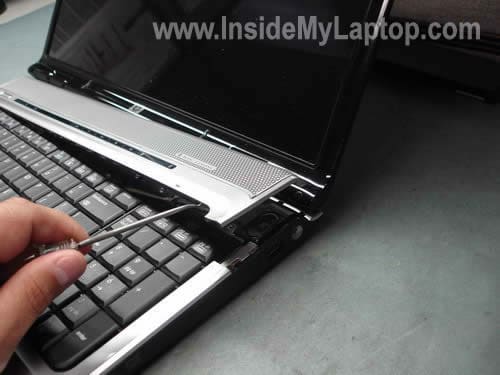
Carefully start removing the keyboard bezel with a small flathead screwdriver.

Be very carefull, the bezel is attached to the motherboard with a flat ribbon cable. The cable location is pointed by the green arrow. Do not disconnect this cable. Simply place the bezel as it shown on the picture below.
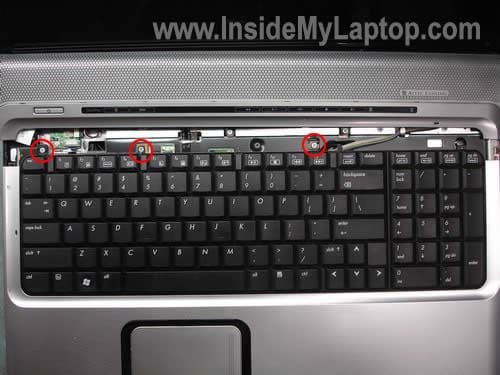
Remove three screws securing the laptop keyboard.

Lift up the keyboard. Be carefull, it's connected to the motherboard.
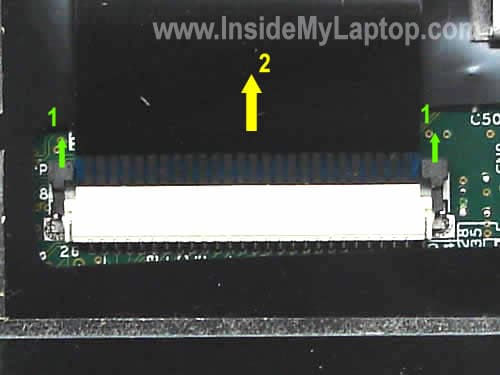
In order to release the keyboard cable, you'll have to unlock the connector as it shown on the picture above.
1. Slide the connector lock to the direction shown by two green arrows with your fingernails.
2. Pull the keyboard cable from the connector.

Now you can remove and replace the keyboard with a new one. You'll find more detailed laptop disassembly instructions in the official service manual for HP Pavilion dv9000 (3.72MB pdf file).
Friday, February 20, 2009
Dell Latitude D610 Series Review
The Dell Latitude D610 is not available through the Home & Home Office section on Dell's site, but through the Business sections of the site. This particular one was purchased through the Dell Small Business section. The Latitude D610 Series is basically your mainstream, thin & light, business notebook. The D610 is ready for any road you may travel. This mainstream business notebook is built for serious mobile performance, incorporating Intel's latest-generation Centrino platform. It's also fairly light (5.4 pounds) and has very good battery life (4 hours)—a winning combination for busy road warriors.
The Latitude D610 is designed for enterprise customers who want flexibility, mobility and convenience in the workplace. These are customers looking for a durable notebook offering the ideal blend features and performance. Starting at less than five pounds, the D610 delivers all the performance you need. Nothing You Don't. All at your fingertips.
Dell Latitude D610 Review Unit System Specs
- Pentium M 760 (2.00Ghz w/ 533Mhz FSB)
- 512MB (2×256) PC3200-DDR2 (400Mhz)
- 14.1″ SXGA+ (1400×1050 resolution)
- ATI Mobility Radeon X300 w/ 64MB dedicated RAM
- Fujitsu 60GB HD (5400RPM)
- 8x DVD+/-RW (dual layer)
- Intel Pro 2200 wireless (802.11 b/g)
- Broadcom Gigabit Ethernet; Conexant 56K modem
- SigmaTel C-Major audio
- Extra AC adapter & extra modular battery
- System total was $1940 after shipping & WA state sales tax
Processor & Performance
The latitude D610 incorporates the latest "Sonoma" version of the Intel Centrino. I had high hopes that this machine would fly, and indeed, the D610 seems very responsive & performs well for what I do. As mentioned above, I'll often have powerpoint, photoshop, deepview (molecular image viewer), word, several instances of firefox, thunderbird, winamp, and a few other applications thrown in for good measure open at the same time. The old Presario would definitely bog-down, especially with graphics intensive apps such as deepview and specific powerpoint slides. So far the Dell Latitude D610 Series battery has sailed through everything I've thrown at it. It hasn't crashed yet — although windows explorer hangs from time to time (doesn't it always). I'm not much of a gamer, although I did download a copy of the Quake3 demo to see how it would run. I'll list the Quake3 results in the benchmarks section below.
Another common use for my notebook is to rip and encode music. I prefer Exact Audio Copy configured to encode with the LAME engine. My "benchmark" here is that the supplied DVD RW drive seems to be able to rip at up to about 7.5x (although it takes a while to get going that fast), and the encoding occurs at a "play/CPU" of about 10x (meaning a 10 minute song is encoded in about 1 minute). All together an hour-long CD is ripped & encoded to high quality VBR mp3 files in about 15 minutes.
Hardware specifications
- Model: Dell Latitude D610
- Processor: Intel Pentium M 760 - Dothan - 2 GHz - 2 MB Cache - 533 MHz FSB
- Chipset: Intel 915GM - ICH6 - Sonoma Centrino
- Memory: 1 GB 533 MHz DDR2 Dual Channel in 2 SDRAM modules
- Hard-drive: 80 GB - 5,400 RPM - Fujitsu MHV2080AH - UDMA133 via S-ATA controller
- Optical drive: Single Layer DVD±R/RW burner - Sony DW-D56A (OEM Liteon SOSW-852S) via S-ATA - 8X DVD - 24X CD
- Wired network: 10/100/1000BaseT Broadcom Corporation NetXtreme BCM5751 Gigabit Ethernet PCI Express
- Wireless network: Intel PRO/wireless 2915 A/B/G
- Bluetooth: Dell Truemobile 350 via USB
- Video:Intel Graphics Media Accelerator 900 with up to 128MB shared1 graphics memory
- Display: 14.1″ SXGA+ (1400×1050) active matrix (TFT)
- Audio: Intel AC'97 with Sigmatel STAC9750/51
- Internal modem: Intel AC'97 with Conexant chip
- Ports: 4 USB 2.0; S-Video; VGA; Serial; Parallel; Infrared; Ethernet(10/100/1000); Modem; Audio In/Out; 1 Type I/II PCMCIA
- Security: Integrated Smart Card Reader and integrated TPM Security Chip
- Desk docking: D-port with DVI video and D-view
- External screen: Dell 2405FPW LCD, 1920×1200
- Battery Cell: Rechargeable li-ion 6-cell latitude d610 series battery
Dell XPS M1330 Review
Dell XPS laptops have been known to pull off performance feats usually associated with desktops. The Dell XPS M1210 (Vista), for instance, has embodied what performance should be like in an ultraportable. But what started off as a stylish design two years ago is now quickly losing ground to trendsetters such as Apple, HP, and Sony. Clearly, it was time for Dell to spice things up. The Dell XPS M1330 ($2,200 direct) is both refreshing and really quite amazing once you factor in both design and performance. Dell slips all the latest technology trends into a very sleek crimson unit while keeping its performance ahead of the competition. It's a breakthrough improvement, which is why I'm giving it the Editors' Choice in the ultraportable category.
If any single notebook can bring Dell out of its recent slump, the XPS M1330 is it. This portable's combination of light weight, stylish design, powerful performance, and built-in mobile broadband makes it a top choice for business travelers and hipsters alike (view photo gallery). Add in a stellar screen and keyboard and long battery life, and you have one of the top contenders for notebook of the year.
The M1330's soft-touch, crimson exterior is a new look for Dell, but the round logo on the lid is reminiscent of the one on the XPS M1210, this system's predecessor. Only 4.8 pounds (or as light as 4 pounds, depending on the battery), our configuration came with a built-in webcam, nine-cell battery, and travel remote. Although the VGA webcam no longer swivels as it did on the M1210, this one comes with tons of capabilities via software, including pan and zoom, face tracking, and special effects. All the webcam features worked reasonably well, and the picture was bright and clear, albeit washed out.
Along the right side you'll find an ExpressCard slot (with a mini remote control inside), a slot-loading DVD+/-RW drive, a Wi-Fi Catcher, and one USB 2.0 port. The left side houses another USB port, along with FireWire, VGA, Ethernet, and HDMI ports. An 8-in-1 memory card reader, dual headphones jacks, and a microphone jack grace the front.
Specification:
Core 2 Duo T7100 1.8GHz, 800MHz FSB, 2MB L2 cache
2×1GB DDR2-667 RAM
13.3″ widescreen LED backlit display WXGA (1280×800) with VGA webcam
NVIDIA GeForce 8400M GS 128MB GDDR3
120GB 5400RPM HDD (Hitachi 5K160 series, 8MB cache)
8X DVD+-RW slot load ODD
Intel Pro/Wireless 3945abg
Fingerprint reader
6-cell and 9-cell batteries
Microsoft Vista Home Premium
Dimensions: 12.5″ (31.8cm) x 9.4″ (23.8cm) x 0.87″-1.33″ (2.21cm-3.38cm)
Weight: 3.97 lbs w/ 4-cell, 4.3lbs w/ 6-cell
Introduction
Dell launched the new line of Inspiron laptops and desktops with much fanfare on June 26th, 2007 at a Macy's department store in New York. The flagship laptop, the dell XPS M1330 battery, garnered a lot of press coverage. The launch coincided with a revamping of Dell's marketing efforts in an attempt to lose the 'beige-box' manufacturer cachet and move more upstream by making the brand more appealing to a wider demographic.
Aside from the redesigns to the notebook line-up, Dell was also touting the multitude of colored lids that the new laptops would ship with, allowing a bit of personalization by customers. In addition, the XPS M1330 was touted as the thinnest 13.3″ notebook and boasted a radically new design for Dell, challenging manufacturers such as Sony and Apple, who were traditionally viewed as more 'stylish' companies, known for their design. There was substantial press coverage for the launch as well as for the new product line, something that hasn't been terribly common for Dell in recent memory. After years of building my own computers, I decided to give Dell a try and ordered the XPS M1330.
The XPS M1330 battery with its 13.3″ widescreen display falls somewhere between the thin-and-light and ultra-portable categories. Its weight, at just under 4 lbs with the 4-cell battery and LED backlit display, puts it squarely in ultra-portable space, but its relatively large footprint means it's not an ultra-portable in the strictest sense of the word. Nevertheless, at under 0.9 inches thick at its thinnest point, with the LED backlit display, it's a very stylish and small laptop, convenient for carrying around and using in all but the tightest of spaces.
The good:
Thin, sexy design; strong performance; backlit-LED display; included media remote control.
The bad:
Small touchpad; some options (SSD hard drives, Blu-ray) not available yet; not as many color options as Dell's new Inspiron line.
The bottom line:
Dell has finally put design first with the head-turning XPS M1330 laptop, emphasizing both the "thin" and "light" aspects of the thin-and-light category without sacrificing features or performance.
Thursday, February 12, 2009
Sony VAIO VGN-S4XP Reviews
 If you're looking for a stylish notebook that offers both power and portability, make sure you add the S4XP to your shortlist. It has faults, but remains a great laptop .
If you're looking for a stylish notebook that offers both power and portability, make sure you add the S4XP to your shortlist. It has faults, but remains a great laptop .
You can get wafer-thin notebooks seemingly as light as air, but with equally lightweight performance. And you can get high-performance notebooks that would shame many desktop PCs, but they're generally hefty, and the sony vaio vgn-s4xp battery will run flat before your coffee gets cold.
Sony's VAIO VGN-S4XP, however, is for those greedy types who want the best of both worlds - in other words, most of us. Stacked inside this chassis is a 2GHz Pentium M 760 processor, together with 1GB of memory and a 100GB hard disk, yet the chassis weighs a smidgen below 2kg. People who spend their lives passing through airport lounges might find this a touch too heavy, but those who just want to travel around town will find the S4XP easily portable.
There's 512MB of PC3200 DDR2 SDRAM on the motherboard, and the same again in the single expansion slot, configured as dual-channel. It's worthwhile having more than 512MB with the graphics card used - an nVidia GeForce Go 6200 - since it uses TurboCache to dynamically augment the modest 32MB of VRAM with system memory. It can only do this thanks to the speed advantages of the PCI Express 16x interface, supplied courtesy of the 915PM Express chipset.
And that gives strong 3D performance for this class of notebook, reaching 20fps in Far Cry and 17fps in Half-Life 2, both at 1,024 x 768 without anti-aliasing or anisotropic filtering. That's not much compared to a desktop gaming machine, but by turning down the quality levels the Vaio VGN-S4XP can play these games satisfactorily. It's no slouch with CPU power either, benchmarking at an astonishingly good 2.08.
Naturally, there are some drawbacks with this level of performance. This chassis is about as small as you'd want to go with the 2GHz CPU, because it produces a lot of heat and needs a large VGP-BPS2 battery to get a useful amount of mobile time. The casing gets warm on the right palmrest, and it also becomes hot underneath, making it uncomfortable on your lap. It gives the fan plenty of exercise when the system is pushed hard too, although it never gets annoyingly noisy. With light use and a dimmed screen, we measured three hours, 12 minutes of battery life - the minimum
That screen is based on X-black technology, which has an anti-glare coating rather than a light-diffusing layer. The light, therefore, isn't scattered as it leaves the screen, giving a brighter image with richer colours. Reflected light isn't scattered either, and this usually gives strong room reflections, but Sony has minimised the problem here. It's halfway between a standard screen and older X-black samples: not as bright as we've come to expect, but not as reflective either. It's a great compromise, and this 13.3in 1,280 x 800-pixel panel is a successful format. Vertical viewing angles are limited, although horizontal angles are wide. Not helpful to privacy on a plane, certainly, but it's good for desktop presentations when you don't have a projector, and the stereo speakers provide ample support.
However, the lid assembly is so thin that there's little resistance to twisting. It also creaks a little and the LCD moves around inside the bezel. Nevertheless, there's reasonable strength in the lid's backing, and you'd have to be fairly rough to damage the LCD from behind. Of equal practical importance, it's worth noting that the screen sits behind the notebook when open, which means you'll need just that bit more room on the tray table of a train or plane.
But the widescreen display also means there's more room for the keyboard, and none of the keys have been excessively trimmed down, as they so often are in smaller notebooks. The important auxiliary keys are in easy-to-find places, such as Control in the lower-left corner and Delete in the upper right. There isn't a great deal of key travel, which may disappoint some buyers, but there's sturdy support below the board and it's a comfortable unit for regular typing. Silver colour coding from the surrounding casing is repeated on the touchpad, although the narrow mouse buttons are a fraction too low in their recesses, requiring accurate thumbing to engage.
A clean look is assured round the sides of the S4XP, with some ports hidden behind little cover doors, such as Ethernet, modem, mini-FireWire and two USBs. There's also Bluetooth and 802.11b/g for connections without wires, and even a dual-layer DVD writer.
There are downsides to this machine. Vaio VGN-S4XP battery life isn't fantastic and it gets warm, so regular ultraportable buyers shouldn't be swayed by the benchmark figures - IBM's X41 is a more nimble alternative. And, just like the X41, the VAIO comes with a minimal one-year return-to-base warranty. But, and admittedly in return for quite a high price, you're buying a good-looking, high-quality notebook. Anyone who wants to skate the fine line between portability and power will love this VAIO.
SPECIFICATIONS:
2GHz Pentium M 760; 1GB PC3200 DDR2 SDRAM; 100GB hard disk; Matsushita UJ-832D DVD writer; 32MB nVidia GeForce Go 6200; 13.3in 1,280 x 800 TFT; V.92 modem; 10/100 Ethernet; Bluetooth; 802.11b/g WLAN; 2 x USB 2; mini-FireWire; Type II PC Card slot; VGA out; Windows XP Professional; 1yr RTB warranty. Dimensions: 314 x 232 x 36mm (WDH). Weight: 1.96kg.
The Article is From: http://www.pcpro.co.uk/reviews/75048/sony-vaio-vgns4xp.html
Wednesday, February 4, 2009
Dell Vostro 1400 Business Laptop Review
This Dell Vostro 1400 laptop has a robust case, balanced configuration, reasonable mass and weight parameters, neat and official appearance (which is important for a business machine), and long battery life. The Vostro 1400 is up to its positioning as a reliable companion for businessmen who travel a lot.
Dell Vostro 1400 is the first 14.1-inch model in the PC maker's Vostro business-class notebook lineup. The 1400, based on Intel's "Santa Rosa" mobile platform, comes in two versions: with an integrated or with a dedicated graphics solution.
The Vostro 1400 is configurable with the latest "Santa Rosa" compatible Intel Core 2 Duo and Celeron processors. The configurations with the integrated Graphics Media Accelerator X3100 are built on Intel GM965 chipset, while those featuring NVIDIA GeForce 8400M GS 128MB discrete video card use PM965 chipset. Dell's new 14.1″ widescreen notebook provides 1280×800 or an optional 1440×900 resolution.
The dell Vostro 1400 battery is offered with up to 4GB of system memory. The usage of more than 3GB requires a 64-bit operating sytem, but this laptop can be purchased online with 32-bit Windows Vista only. The Vostro 1400 comes with up to 160GB hard drive at 5400rpm or an optional 160GB unit at 7200rpm.
For networking and communications, there are a wireless LAN supporting 802.11n draft standard optionally, an Ethernet LAN, a 56k modem, and an optional Bluetooth, as well as a choice of AT&T, Sprint and Verizon mobile broadband modules. In addition, for video conferencing you can have a built-in 2 megapixel web camera, mounted on the top of the display panel.
Dell Vostro 1400 has an ExpressCard slot, four USB ports, an 8-in-1 media card reader, a infra-red sensor, a Firewire, and VGA and S-Video outputs.
It features the same hardware specifications and a case shape as Dell Inspiron 1420 battery consumer notebook. However, the business-oriented Vostro is black, while the Inspiron 1420 is offered in eight different colors.

Specifications:
- Core 2 Duo T5470 (1.6Ghz, 2MB L2 Cache, 800MHz FSB)
- 14.1" Wide Screen XGA LCD Display with TrueLife
- 1GB DDR2 667Mhz
- 128MB Nvidia Geforce 8400GS
- 120GB 5400RPM SATA
- Genuine Windows Vista Home Basic
- Integrated 10/100 Network Card and Modem
- 8x CD/DVD Burner w/ double layer DVD+ write capability
- Integrated High Definition Audtio
- Dell Wireless 1390 802.11g Wi-Fi Mini Card
- Integrated 2.0 mega pixel web camera
- 85 WHr 9-cell Lithium Ion Primary Battery
- Dell Wireless 355 Bluetooth Internal (2.0 + Enhanced Data Rate)
- 1 Year Limited Hardware Warranty with Mail-in Service
Dell has been launch their new notebook system on the market with Core 2 Duo processor it's called Dell Vostro 1400 battery. Vistro notebook exclusively for small business and can be costumize with feature and software. The Vostro 1400 packages has a light system, thin, stylish and is a good for traveler technology with wireless connectivity, durability and widescreen display.
The latest Intel Core 2 Duo processor T7100 (1.8 GHz) which is have 28% greater performance than the prior generation and long life battery. Mutlitasking can be fast performance with 4GB memory DDR2. To maximize the connectivity, Vostro 1400 available with next generation Wireless-N type Wifi - up to 5x faster throughput and it can be used with wireless N router. The durability and reliability with magnesium alloy chassis, sealed keyboard, steel hinges and over 13,000 hours of teting for Dell Notebooks.
Feature with 14 inch widescreen display with TrueLife Technology, the weight just 1.45 kg for outstanding mobility and 4 USB port 2.0 for convenient connectivity. Also feature with 8-in-1 media card reader for quickly transfer media files. The graphic card come with 128 MB DDR2 NVIDIA GeForce Go 8400M GS and DVD+/-RW with Dual Layer DVD+R write capacity.
The powered with 9 cell dell vostro 1400 battery 85 WHr Li-Ion Battery, camera integrated 2.0 megapixel in LCD back with camera indicator and 2 digital microphone. The storage drive up to 160GB configured with a single 7200 or 5400 RPM SATA.
Monday, February 2, 2009
Dell LATITUDE X300 SERIES Laptop Battery
Brand New hi-quality Dell LATITUDE X300 SERIES Laptop Battery! You can back up your system with this Li-ion Replacement Battery. With a capacity of 4400mAh, the Dell LATITUDE X300 SERIES battery lets you work seamlessly when you are on the move for business trips or vacations. This rechargeable battery for dell LATITUDE X300 SERIES has been tested and validated on Dell systems to ensure it will work with your computer.
Specifications:
- Chemistry: Li-Ion
- Capacity: 4400mAh
- Voltage: 14.8V
- Color: Silver
- Dimension: 273.20 x 94.35 x 15.60 mm
- Net Weight: 455.5g
- Condition: Brand new with one year warranty!
The Dell LATITUDE X300 SERIES Laptop Batteries offered by us are compatible with certain products of batteries manufacturers. All the information presented on this website may contain references to products or trademarks maintained by such manufacturers, which is solely to show the batteries with which our products are compatible.
Replacement for The Following Battery Code
Dell 312-0106 , Dell 312-0107 , Dell 312-0148 , Dell 312-0151 , Dell 312-0298 , Dell 451-10148 , Dell 451-10149 , Dell C6109 , Dell F0993 , Dell G0767 , Dell P0382 , Dell U0386 , Dell W0391 , Dell W0465 , Dell X0057 , Dell Y0037
Work With The Following Laptop Models
Dell LATITUDE X300 SERIES






